Yeohelmetguy
Well-known member
CONTINUED FROM BRITISH OFFICERS HOME SERVICE HELMET PLATES 1878-1901 A SAMPLING PART ONE, PLEASE BE SURE TO LOOK AT THE HELMET PLATES IN PART ONE WHICH ALSO CONTAINS THE INTRODUCTION TO BOTH POSTS:
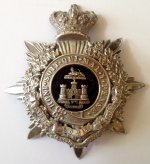
Helmet Plate attributed to The Essex Regiment, 2nd Volunteer Battalion, all silver plate, central device, the Castle and Key with the Sphinx over Egypt above and a small scroll below inscribed “Montis Insignia Calpe” on black velvet. The universal laurel wreath is replaced by a wreath od oak leaves. The silver universal title scrolls below inscribed “The Essex Regiment” and below that a second scroll inscribed “2nd Volunteer Battalion”.
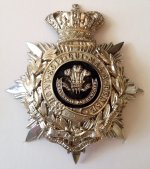
Helmet Plate attributed to The Welsh Regiment, 2nd (Glamorgan) Volunteer Battalion 1887-1901, silver/silver plate with central device, the Prince of Wales’s plume with a scroll below inscribed “Gwell Angau Na Chywilydd” on a black velvet ground. On the silver universal title scroll inscribed “The Welsh Regiment” with a second scroll below that inscribed “2nd Volunteer Battalion”.
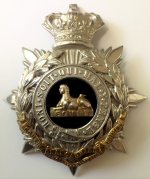
Helmet Plate attributed to the South Lancashire Regiment, 1st Volunteer Battalion by Hobson & Son 1883 to 1901, silver star plate and garter with gilt regimental title scroll inscribed “South Lancashire Regiment” and below that a second scroll inscribed “1st Volunteer Battalion” and sphynx and tablet inscribed "Egypt" on a black velvet ground. Hobson & Sons makers plate to the rear of the plate.
OFFICERS VOLUNTEER AND MILITIA REGIMENTS 1878-1881:
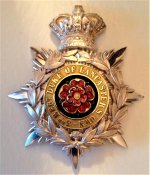
Helmet Plate, 3rd Regt, Duke of Lancaster's Own (Militia). The 3rd Regiment, Duke of Lancaster’s Own was formally embodied for service on 25 February 1798, and was placed on a permanent footing as the 3rd Royal Lancashire Militia in 1800. The 3rd Royal Lancashire Militia was linked with the 47th (Lancashire) and 81st (Loyal Lincoln Volunteers) Regiments of Foot in Sub-District No 12 (Lancashire), with the depot established at Fulwood Barracks in Preston. The Childers Reforms completed the process by incorporating the militia battalions into the expanded county regiments. On 1 July 1881 the 47th and 81st Foot became the 1st and 2nd Battalions of the Loyal North Lancashire Regiment with the 3rd Royal Lancashire Militia (The Duke of Lancaster's Own) as its 3rd Battalion. The plate is all silver with a gilt garter strap inscribed with the regimental title “3rd Duke of Lancasters Own” and within the garter an enameled red Lancashire rose.
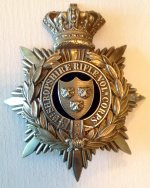
Helmet Plate attributed to the1st Shropshire Rifle Volunteer Corps as worn 1880 through 1887. Shropshire formed no fewer than 18 companies between 1859-60. By 1863 this number dropped to 16, however each company still consisted of around 100-120 men drawn from local trades and businesses. These part-time soldiers were required to do a number of days training each year as well as attending an annual fortnight’s camp. The 16 Shropshire companies were divided up into two “Administrative Battalions” (1st and 2nd Administrative Battalion with Headquarters at Shrewsbury) and in 1880 these would become the 1st and 2nd Shropshire Rifle Volunteer Corps, then renamed again in 1887 as the 1st and 2nd Volunteer Battalions, King’s Shropshire Light Infantry. The helmet plate is all silver with the central device set on black velvet.
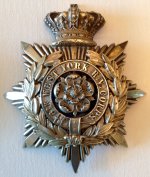
Helmet Plate attributed to the 6th (The Huddersfield) West York Rifle Volunteer Corps as worn from 1878 through 1881. In February 1883 as a result of the Childers Reforms, the Corps was redesignated the 2nd Volunteer Battalion, the Duke of Wellington's (West Riding) Regiment with headquarters at The Armoury in Ramsden Street, Huddersfield. The uniform had been scarlet with sky blue facing, but the facings were changed to the standard white by 1887. The helmet plate is all silver with a Yorkshire Rose central device set on a black velvet ground. Ther are also known examples of this plate that have “6th” spelled out as “SIXTH”.
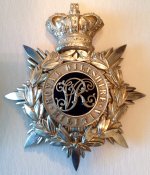
Helmet Plate attributed to the Royal Wiltshire Militia as worn from 1878 through 1881. All silver with silver central device, an intertwined “VR” cypher/monogram mounted on a black velvet ground surrounded by a circle inscribed “Royal Wilts Militia”. In 1881 under the Childers Reforms the Royal Wiltshire Militia was transferred to The Duke of Edinburgh's (Wiltshire) Regiment as its 3rd Battalion.
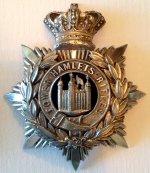
Helmet Plate attributed to the Tower Hamlets Rifles as worn between 1878 and 1881. The unit was formed as the 1st Administrative Battalion, Tower Hamlets Rifle Volunteer Corps in May 1861 by the grouping of six smaller rifle volunteer corps that were formed in 1860. The headquarters were established at Truman's Brewery, Spitalfields. In 1880 it was renamed and reorganized as 3rd Tower Hamlets Rifle Volunteer Corps, with headquarters at Whitechapel Road. In 1881 it became a volunteer battalion of the Rifle Brigade. In 1894 the headquarters were moved to Bow. On 1st April 1908 the Territorial Force was formed, and all volunteer infantry battalions in the County of London became part of a new London Regiment. The 3rd Tower Hamlets VRC became 17th (County of London) Battalion, The London Regiment (Poplar and Stepney Rifles).
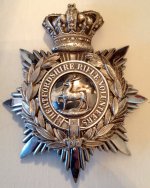
Helmet Plate attributed to the Hertfordshire Rifle Volunteers, all silver plate, with the Hert mounted on a royal blue velvet backing to the central device now missing. The circular garter inscribed with the regimental title “Hertfordshire Rifle Volunteers”.
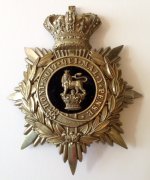
Helmet Plate attributed to the (1st or) Royal North Lincolnshire Militia Regiment as worm from 1878 through1881, silver plate with central device, the Royal Crest, mounted on a royal blue velvet backing. In 1881 the Royal North Lincolnshire Militia became the 3rd (Militia) Battalion, Royal Lincolnshire Regiment and served as a reserve battalion to the regiment.
Best regards to all,
David

Helmet Plate attributed to The Essex Regiment, 2nd Volunteer Battalion, all silver plate, central device, the Castle and Key with the Sphinx over Egypt above and a small scroll below inscribed “Montis Insignia Calpe” on black velvet. The universal laurel wreath is replaced by a wreath od oak leaves. The silver universal title scrolls below inscribed “The Essex Regiment” and below that a second scroll inscribed “2nd Volunteer Battalion”.

Helmet Plate attributed to The Welsh Regiment, 2nd (Glamorgan) Volunteer Battalion 1887-1901, silver/silver plate with central device, the Prince of Wales’s plume with a scroll below inscribed “Gwell Angau Na Chywilydd” on a black velvet ground. On the silver universal title scroll inscribed “The Welsh Regiment” with a second scroll below that inscribed “2nd Volunteer Battalion”.

Helmet Plate attributed to the South Lancashire Regiment, 1st Volunteer Battalion by Hobson & Son 1883 to 1901, silver star plate and garter with gilt regimental title scroll inscribed “South Lancashire Regiment” and below that a second scroll inscribed “1st Volunteer Battalion” and sphynx and tablet inscribed "Egypt" on a black velvet ground. Hobson & Sons makers plate to the rear of the plate.
OFFICERS VOLUNTEER AND MILITIA REGIMENTS 1878-1881:

Helmet Plate, 3rd Regt, Duke of Lancaster's Own (Militia). The 3rd Regiment, Duke of Lancaster’s Own was formally embodied for service on 25 February 1798, and was placed on a permanent footing as the 3rd Royal Lancashire Militia in 1800. The 3rd Royal Lancashire Militia was linked with the 47th (Lancashire) and 81st (Loyal Lincoln Volunteers) Regiments of Foot in Sub-District No 12 (Lancashire), with the depot established at Fulwood Barracks in Preston. The Childers Reforms completed the process by incorporating the militia battalions into the expanded county regiments. On 1 July 1881 the 47th and 81st Foot became the 1st and 2nd Battalions of the Loyal North Lancashire Regiment with the 3rd Royal Lancashire Militia (The Duke of Lancaster's Own) as its 3rd Battalion. The plate is all silver with a gilt garter strap inscribed with the regimental title “3rd Duke of Lancasters Own” and within the garter an enameled red Lancashire rose.

Helmet Plate attributed to the1st Shropshire Rifle Volunteer Corps as worn 1880 through 1887. Shropshire formed no fewer than 18 companies between 1859-60. By 1863 this number dropped to 16, however each company still consisted of around 100-120 men drawn from local trades and businesses. These part-time soldiers were required to do a number of days training each year as well as attending an annual fortnight’s camp. The 16 Shropshire companies were divided up into two “Administrative Battalions” (1st and 2nd Administrative Battalion with Headquarters at Shrewsbury) and in 1880 these would become the 1st and 2nd Shropshire Rifle Volunteer Corps, then renamed again in 1887 as the 1st and 2nd Volunteer Battalions, King’s Shropshire Light Infantry. The helmet plate is all silver with the central device set on black velvet.

Helmet Plate attributed to the 6th (The Huddersfield) West York Rifle Volunteer Corps as worn from 1878 through 1881. In February 1883 as a result of the Childers Reforms, the Corps was redesignated the 2nd Volunteer Battalion, the Duke of Wellington's (West Riding) Regiment with headquarters at The Armoury in Ramsden Street, Huddersfield. The uniform had been scarlet with sky blue facing, but the facings were changed to the standard white by 1887. The helmet plate is all silver with a Yorkshire Rose central device set on a black velvet ground. Ther are also known examples of this plate that have “6th” spelled out as “SIXTH”.

Helmet Plate attributed to the Royal Wiltshire Militia as worn from 1878 through 1881. All silver with silver central device, an intertwined “VR” cypher/monogram mounted on a black velvet ground surrounded by a circle inscribed “Royal Wilts Militia”. In 1881 under the Childers Reforms the Royal Wiltshire Militia was transferred to The Duke of Edinburgh's (Wiltshire) Regiment as its 3rd Battalion.

Helmet Plate attributed to the Tower Hamlets Rifles as worn between 1878 and 1881. The unit was formed as the 1st Administrative Battalion, Tower Hamlets Rifle Volunteer Corps in May 1861 by the grouping of six smaller rifle volunteer corps that were formed in 1860. The headquarters were established at Truman's Brewery, Spitalfields. In 1880 it was renamed and reorganized as 3rd Tower Hamlets Rifle Volunteer Corps, with headquarters at Whitechapel Road. In 1881 it became a volunteer battalion of the Rifle Brigade. In 1894 the headquarters were moved to Bow. On 1st April 1908 the Territorial Force was formed, and all volunteer infantry battalions in the County of London became part of a new London Regiment. The 3rd Tower Hamlets VRC became 17th (County of London) Battalion, The London Regiment (Poplar and Stepney Rifles).

Helmet Plate attributed to the Hertfordshire Rifle Volunteers, all silver plate, with the Hert mounted on a royal blue velvet backing to the central device now missing. The circular garter inscribed with the regimental title “Hertfordshire Rifle Volunteers”.

Helmet Plate attributed to the (1st or) Royal North Lincolnshire Militia Regiment as worm from 1878 through1881, silver plate with central device, the Royal Crest, mounted on a royal blue velvet backing. In 1881 the Royal North Lincolnshire Militia became the 3rd (Militia) Battalion, Royal Lincolnshire Regiment and served as a reserve battalion to the regiment.
Best regards to all,
David
Last edited:
